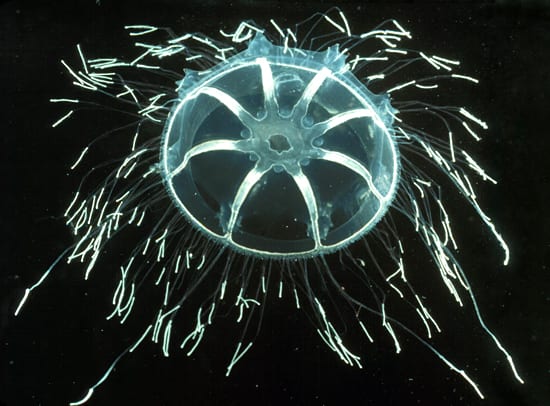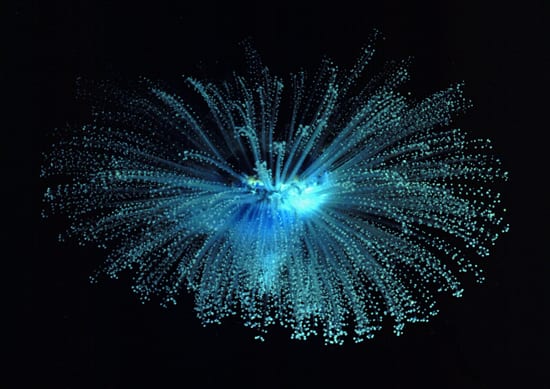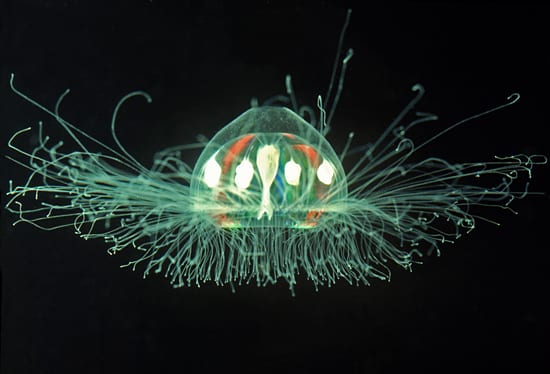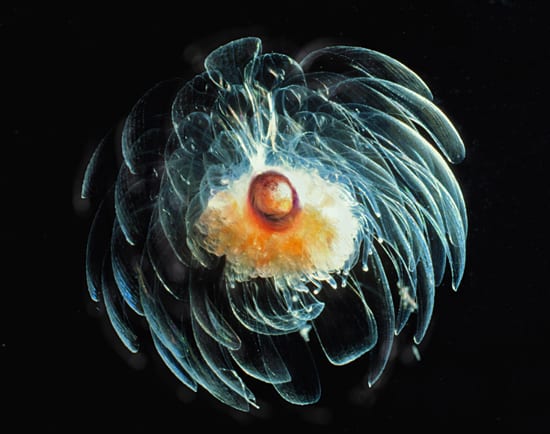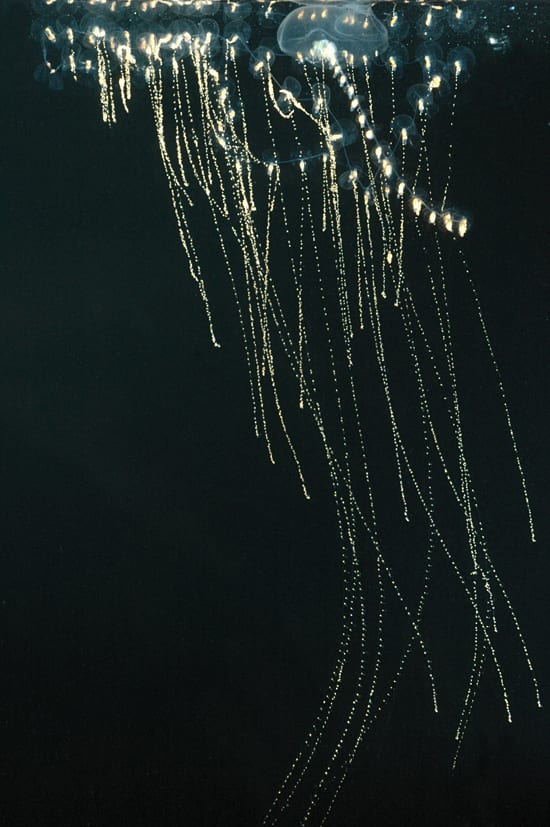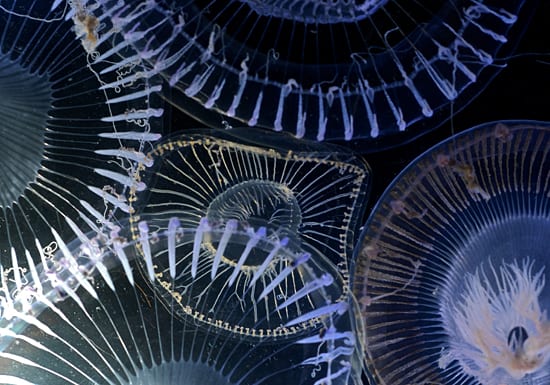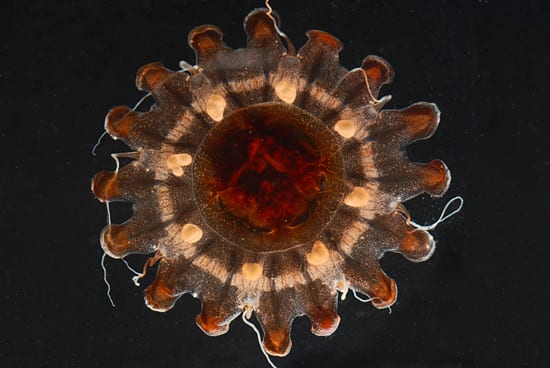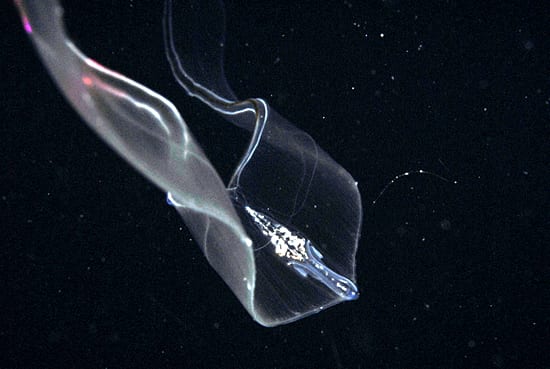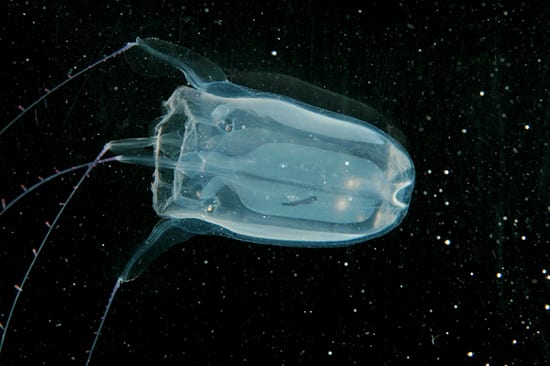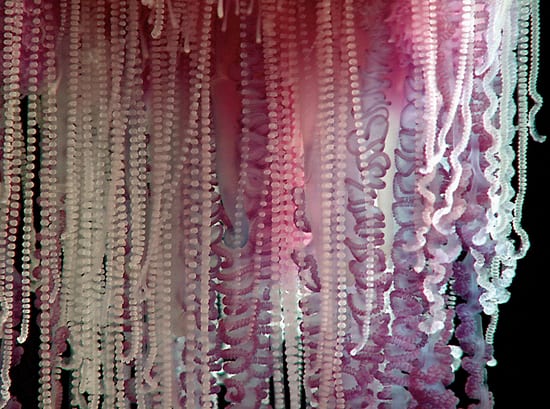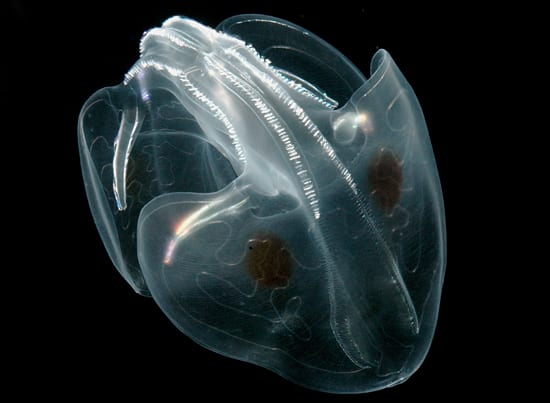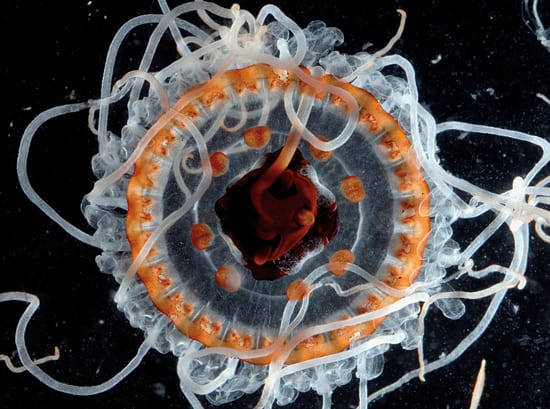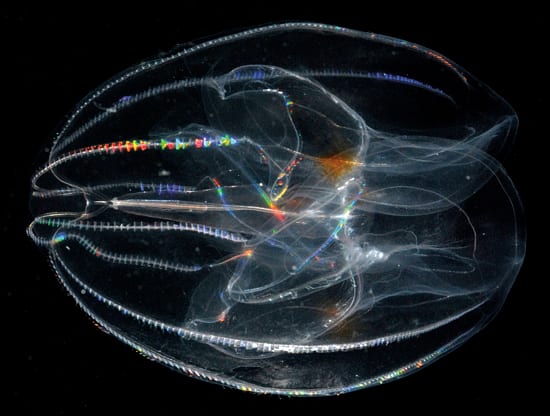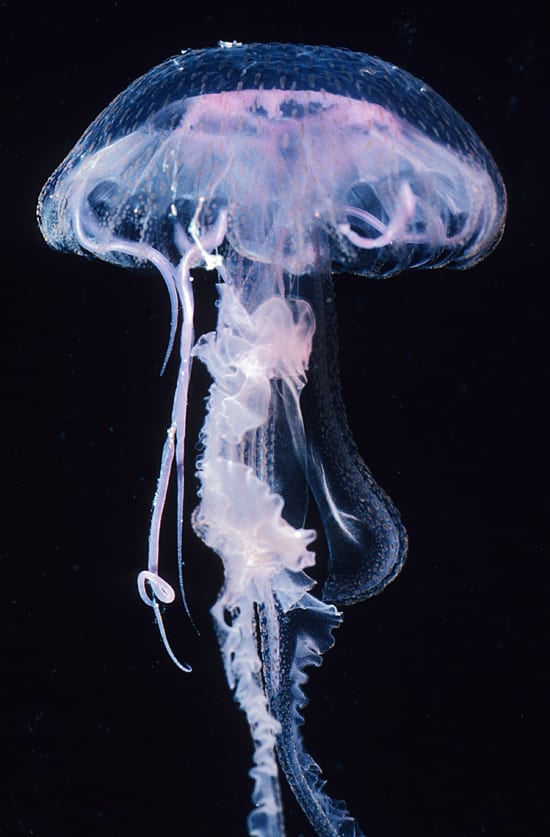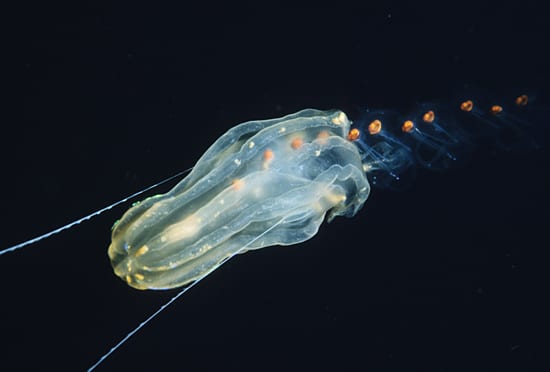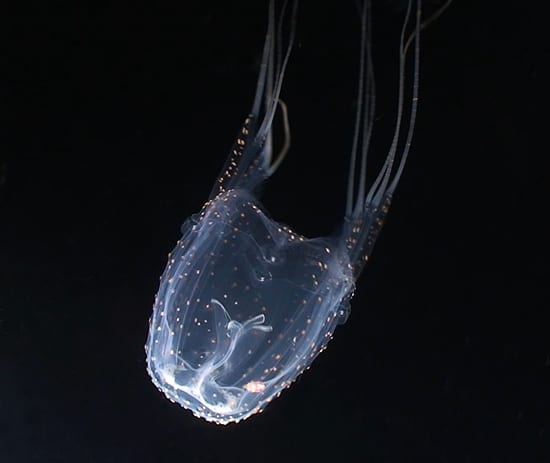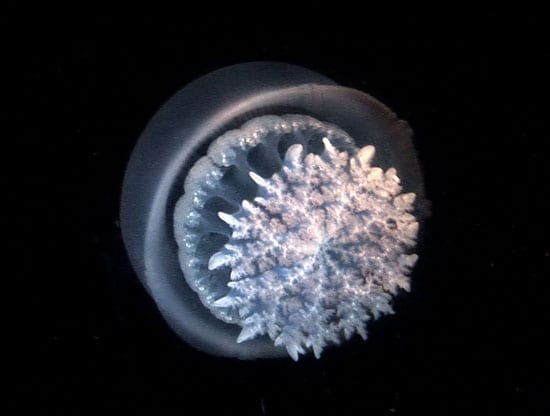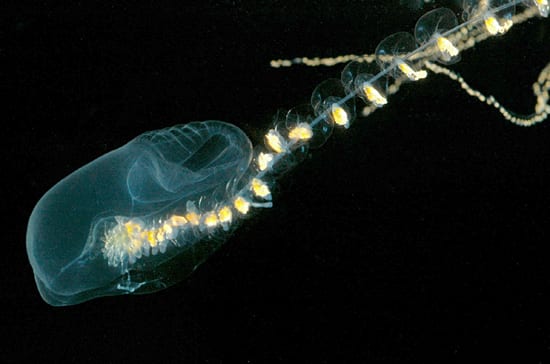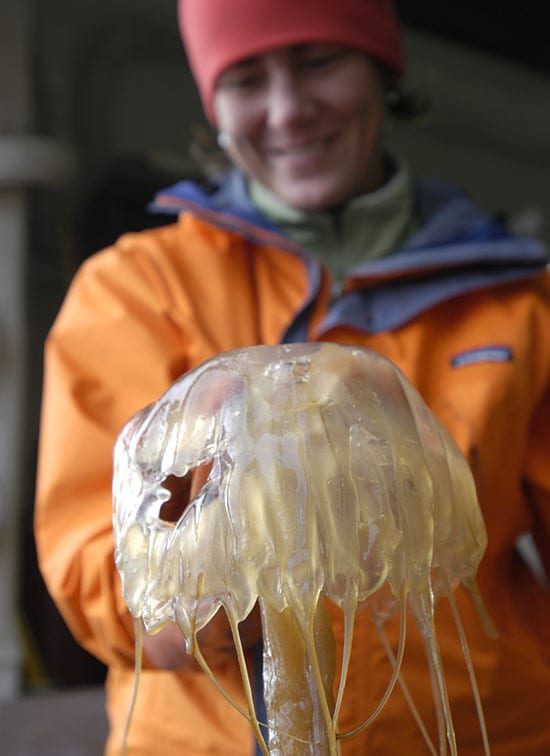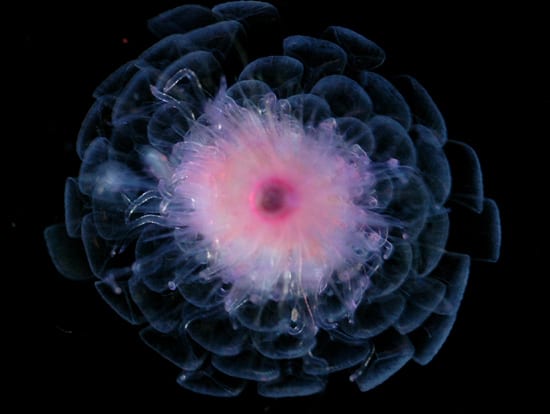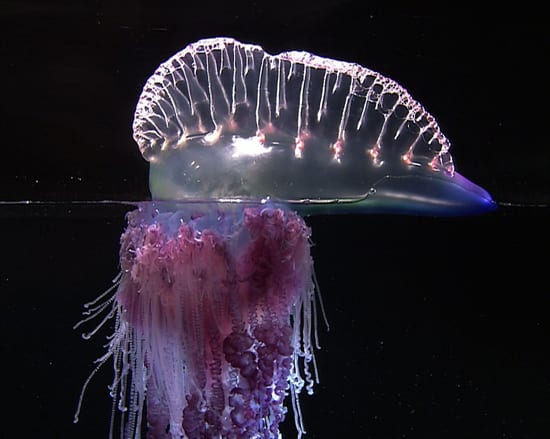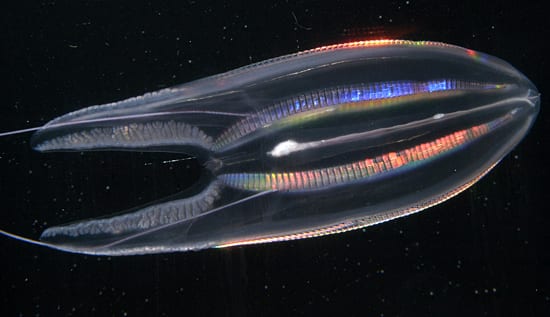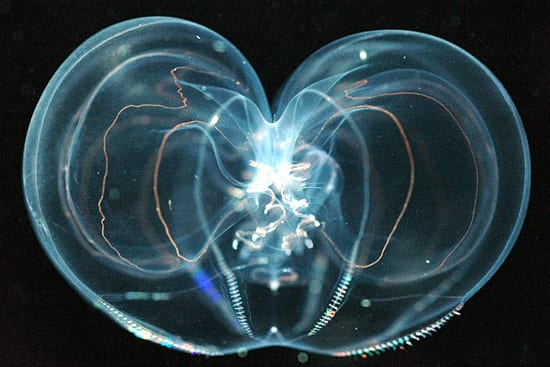- Probably the most familiar jellies are jellyfish, such as this one—technically called medusae, and belonging to two divisions of the phylum Cnidaria. Jellyfish are predators that use tentacles studded with stinging cells to catch and kill their prey, usually smaller zooplankton or fish. Although jellyfish have a very simple body structure, with no central nervous system, all have evolved efficient ways to catch their food. They swim by jet propulsion, and many are capable of complex migration patterns. In many species, the medusa is a stage that alternates with another form that lives attached to the bottom. (Photo by Larry Madin, Woods Hole Oceanographic Institution)
- Is it fireworks, a flower, or a 1970's fiber-optics lamp? None of the above!—it's a colonial ocean animal related to jellyfish, called Porpita porpita. The colony has radiating blue "tentacles"—really the individual units of the colony— that sting and catch tiny animals, and a gas-filled float to help it stay at the ocean surface. (Photo by Larry Madin, Woods Hole Oceanographic Institution)
- The jellyfish Crossota alba. Delicate jellyfish such as this thrive in the deep sea, where no wind, waves, or turbulence threaten to tear them apart, and are successful predators in spite of their fragility. In the quiet, dark environment this transparent, inch-wide animal sits motionless, with stinging tentacles arranged like fishing lines in a circle, and waits to encounter prey—ambushing, rather than stalking its food. (Photo by Larry Madin, Woods Hole Oceanographic Institution)
- The deep ocean is home to hundreds of species with soft, jelly-like tissues. Many of these gelatinous animals are transparent, and many are beautiful. Siphonophores, such as the one pictured, are closely related to jellyfish. But instead of one umbrella-shaped bell, they are made of multiple units specialized for feeding, swimming, or reproduction—each "petal" of this animal is one of these repeating parts. Such modular construction allows some deep-sea siphonophores to grow to more than 100 feet long. (Photo by Larry Madin, Woods Hole Oceanographic Institution)
- Siphonophores, relatives of jellyfish made of compound units, drift in the endless space of the open ocean. Their many tentacles, studded with batteries of stinging cells, form a beaded curtain of deadly fishing lines to catch prey. Researchers found this foot-long siphonophore (Rosacea) in the Sargasso Sea, on a 2006 cruise on the NOAA ship R/V Ron Brown to catalogue planktonic animals and sequence their DNA—part of the Census of Marine Zooplankton project. (Photo by Larry Madin, Woods Hole Oceanographic Institution)
- Scientists of the “Inner Space Speciation Project”—a four-week expedition led by WHOI biologist Larry Madin to look for new species in Southeast Asia’s Celebes Sea —used a wide range of methods to sample ocean life. Most jellyfish are so fragile that they are destroyed when collected with a plankton net. Scuba divers carried collecting bags filled with glass jars to collect delicate animals near the surface, such as these Aequorea jellyfish. (Photo by Larry Madin, Woods Hole Oceanographic Institution)
- In 2007 WHOI biologist Laurence Madin led a team of scientists and photographers from the U.S. and the Philippines on an expedition to explore biodiversity in the deep Celebes Sea. The deep ocean is a dark environment where the only light come from bioluminescent animals, those that produce light that may help them find mates or lure food. But what if a transparent animal eats a luminescent animal that then flashes in the predator’s stomach? Would that advertise its whereabouts to larger hungry animals? Scientists believe that many deep-sea animals, like this jellyfish, have red pigment around their stomachs to keep their prey’s light from escaping. (Photo by Laurence Madin, Woods Hole Oceanographic Institution)
- Looping through the open ocean, this ribbon-shaped jelly-like animal, called a "Venus' girdle" comb jelly, catches food with a sticky substance. This one was seen in the ocean off the Phoenix Islands chain in the equatorial Pacific where an international team of scientists, divers, photographers and officials are on a 3-week research mission to survey what may be the most pristine, intact coral reef ecosystems on Earth. (Photo by Larry Madin, Woods Hole Oceanographic Institution)
- This jellyfish is called a box-jelly, or a cubomedusa. This type of jellyfish can deliver toxic stings, so it was collected very carefully by a researchers working in the Phoenix Islands, a remote archipelago of coral islands in the equatorial Pacific. The islands, their coral reefs and surrounding water are part of the Phoenix Islands Protected Area, the largest marine reserve in the world. (Photo by Larry Madin, Woods Hole Oceanographic Institution)
- It looks like a curtain of Mardi Gras beads hung in a doorway, but fish should choose another door! These are a Physalia’s (Man-o’-War jelly’s) tentacles hanging beneath its ship-shaped surface float. The “beads” are batteries of stinging cells that inject toxin into any creature they contact. Deadly to small prey, the sting is very painful for humans. This particular image graces the month of February in WHOI's recently released 2010 wall calendar, featuring the beauty of zooplankton. (Photo by Larry Madin, Woods Hole Oceanographic Institution)
- Depending on interpretation, this view of the ctenophore Ocyropsis maculata looks like either an ancient Greek helmet or a clamshell bucket for earth-moving machines. This large (to 6”) predator uses its broad lobes to catch small crustaceans, rolling them up like a baseball glove catching a ball. It also uses them to swim rapidly away from trouble. (Photo by Larry Madin, Woods Hole Oceanographic Institution)
- The jellyfish Atolla lives worldwide in the deep sea, where light levels are very low. The jellyfish is bioluminescent—emitting blue-green light—and so are most of its prey. Scientists think that the deep red color of the animal’s stomach serves a purpose—to keep the blue light of its luminescent lunch from escaping and giving away Atolla’s location to its own predators. (Photo by Larry Madin, Woods Hole Oceanographic Institution)
- Ctenophores (comb jellies) swim by beating rows of tiny combs along their bodies. Sunlight—or a photographer’s strobe—on the combs creates diffraction patterns—flickering rainbows running down the rows. Most ctenophores are also bioluminescent, producing light of their own. Ctenophores are predators, and several species, including this two-inch Bolinopsis, can have a large impact on fish populations near coasts by consuming fish larvae. (Photo by Larry Madin, Woods Hole Oceanographic Institution)
- Elegant and diaphanous, the jellyfish Pelagia noctiluca is pretty, but packs a punch. These jellies (also called “purple-striped jelly” or “mauve stinger”) produce bright bioluminescent light (noctiluca means “night light”) and feed by catching smaller plankton animals, or zooplankton, on tentacles laden with stinging cells. Common in coastal waters of most oceans, they can cause problems for humans—swarms of thousands of Pelagia plagued Mediterranean beaches in summer 2008, causing painful stings to swimmers. (Photo by Laurence Madin, Woods Hole Oceanographic Institution)
- Many kinds of gelatinous and transparent "jellies" inhabit the oceans, and some even eat other jellies. On the left—biting off more than it can chew—is Lampea pancerina, a species of ctenophore, or “comb jelly." It speciallizes in eating salps (gelatinous animals that eat tiny marine plants) and can stretch to consume meals much bigger than itself. Scientists find that jellies have much to offer science; they even played a role with Nobel Prize-winning research this week. Chemists from Japan and America, including one affiliated with Woods Hole, won for their development of a green fluorescent protein from jellyfish that has provided researchers a new window into the workings of the cell. The fluorescent proteins are used for observing the growth and fate of specific cells, like nerve cells, damaged during Alzeheimer's disease or due to tumors. (Photo by Laurence Madin, Woods Hole Oceanographic Institution)
- MIT/WHOI Joint Program student Kelly Rakow Sutherland captured this image of a box jellyfish (Carybdea sp.) during a night scuba dive off the Pacific coast of Panama at the Liquid Jungle Lab. Box jellyfish, also known as sea wasps, are predatory hunters that can deliver potent stings to swimmers. Less appreciated is that box jellies posses image-forming eyes that allow them to distinguish between light and shadow. (Photo by Kelly Rakow Sutherland, Woods Hole Oceanographic Institution)
- This specimen of Stomolophus meleagris—aka "cannonball jellies" or "cabbage head jellies"—was captured for study from the waters around the Liquid Jungle Laboratory in Panama. Biology graduate student Kelly Rakow, and her mentor Larry Madin, collect jelly animals in an effort to document which gelatinous creatures live in particular environments. Cannonball jellies are peculiar in that they (like corals) have zooxanthellae, or photosynthetic symbionts, embedded in their tissues. (Digital video capture by Kelly Rakow, Woods Hole Oceanographic Institution)
- This "colonial" jelly—a siphonophore of the Rosacea genus—was spied in April 2006 by divers in the blue waters of the Sargasso Sea during a Census of Marine Zooplankton cruise. Siphonophores are made up of multiple units, each specialized for a function like swimming, feeding, or reproduction. This "modular" construction allows some siphonophores to grow very large, over 100 feet in the deep ocean. (Photo by Laurence Madin, Woods Hole Oceanographic Institution)
- This medusa was "captured" when it got tangled in equipment during an Arctic cruise. This jellyfish--which is the size of a human head, with tentacles six feet long--is a fairly common variety known as Cyanea sp. (Photo by Chris Linder, Woods Hole Oceanographic Institution)
- This specimen of Athorybia, a siphonophore or colonial jellyfish, was collected recently from a Census of Marine Zooplankton cruise off the U.S. East Coast. Researchers found many new species in water as deep as 4,500 meters (15,000 feet). (Photo by Laurence Madin, Woods Hole Oceanographic Institution)
- Physalia physalis, commonly known as the Portuguese man-of-war or bluebottle, lives in warm waters worldwide and is famous for its painful stinging tentacles up to 50 meters (165 feet) long. The gas-filled float and crest at top acts like a sail. (Photo by Laurence Madin, Woods Hole Oceanographic Institution)
- A ctenophore (pronounced teen-o-fore), or comb jelly, is a transparent jelly-like animal often spherical or bell-shaped. When light strikes the eight rows of comb-like paddles used for movement, it is diffracted into colors like a rainbow. (Photo by Laurence Madin, Woods Hole Oceanographic Institution)
- The comb jelly, Thalassocalyce, is found in surface waters and midwater regions of the Atlantic Ocean, Mediterranean Sea, and sometimes in central California waters when warmer Pacific Ocean waters come inshore. Its bell-shaped body opens wide to capture prey. (Photo by Laurence Madin, Woods Hole Oceanographic Institution)
SEARCH RELATED TOPICS: Jellyfish & Other Zooplankton
Image and Visual Licensing
WHOI copyright digital assets (stills and video) contained on this website can be licensed for non-commercial use upon request and approval. Please contact WHOI Digital Assets at images@whoi.edu or (508) 289-2647.
